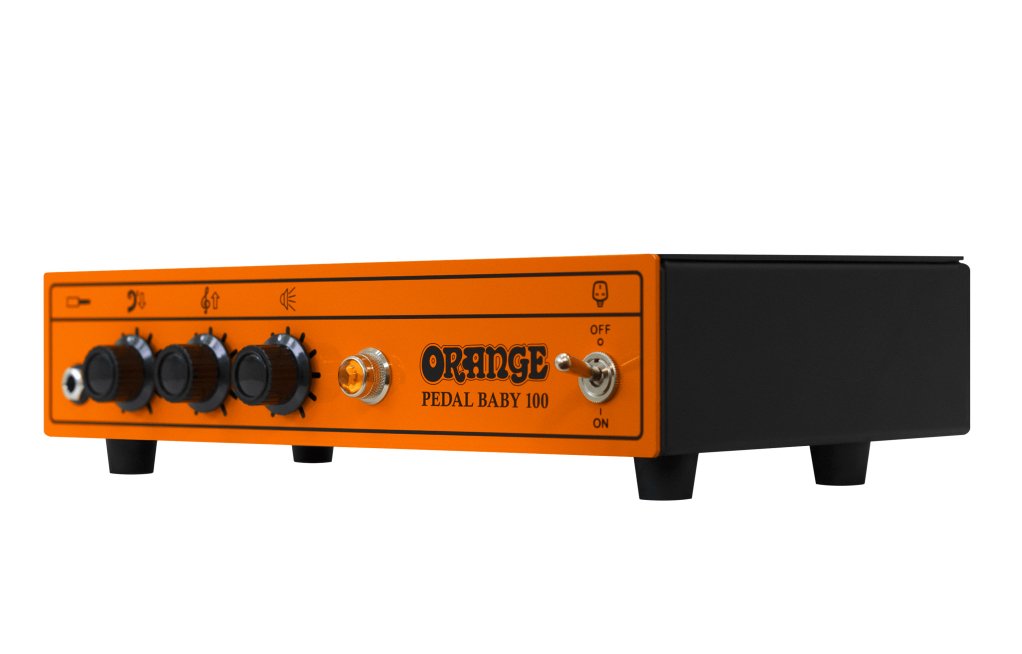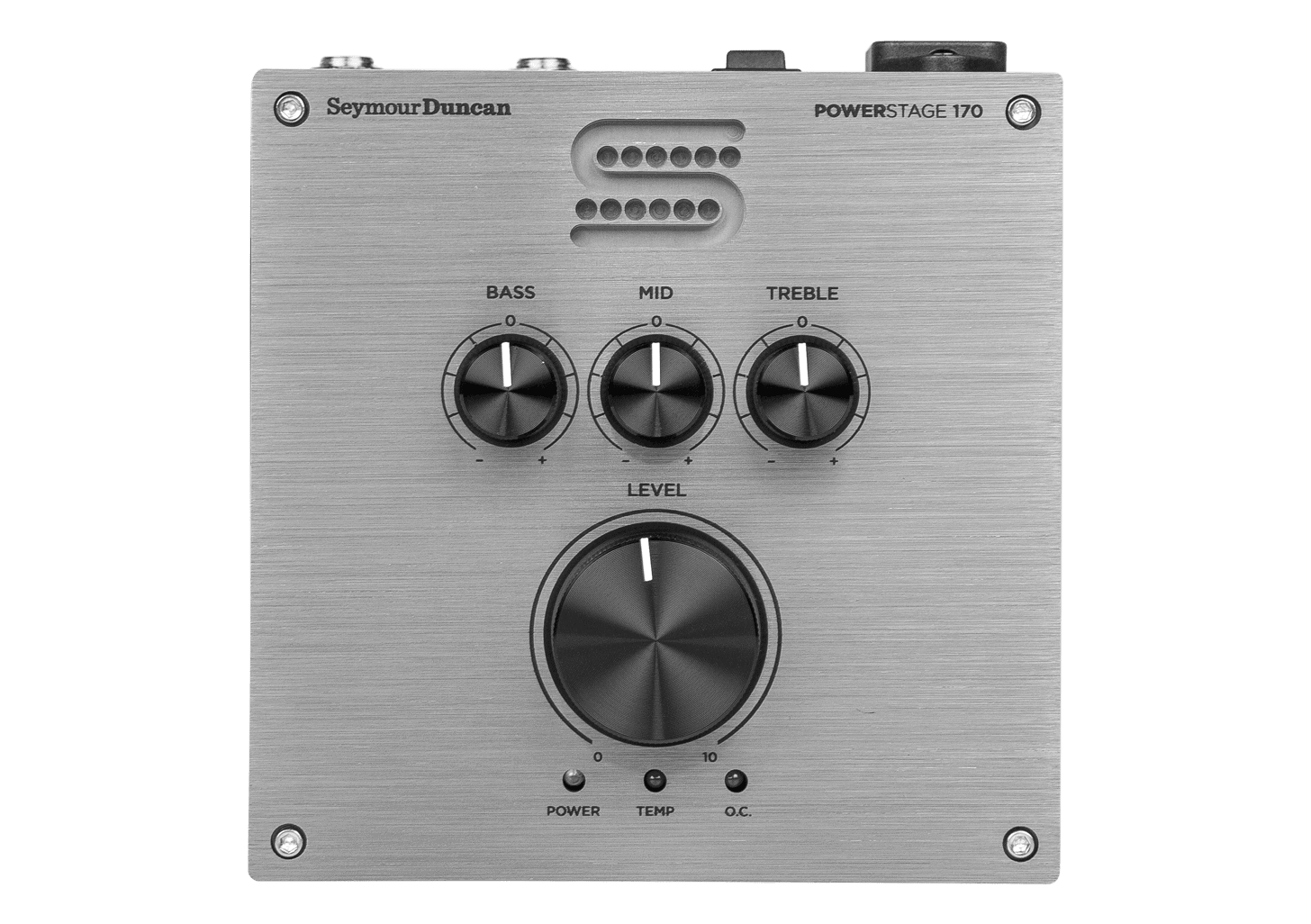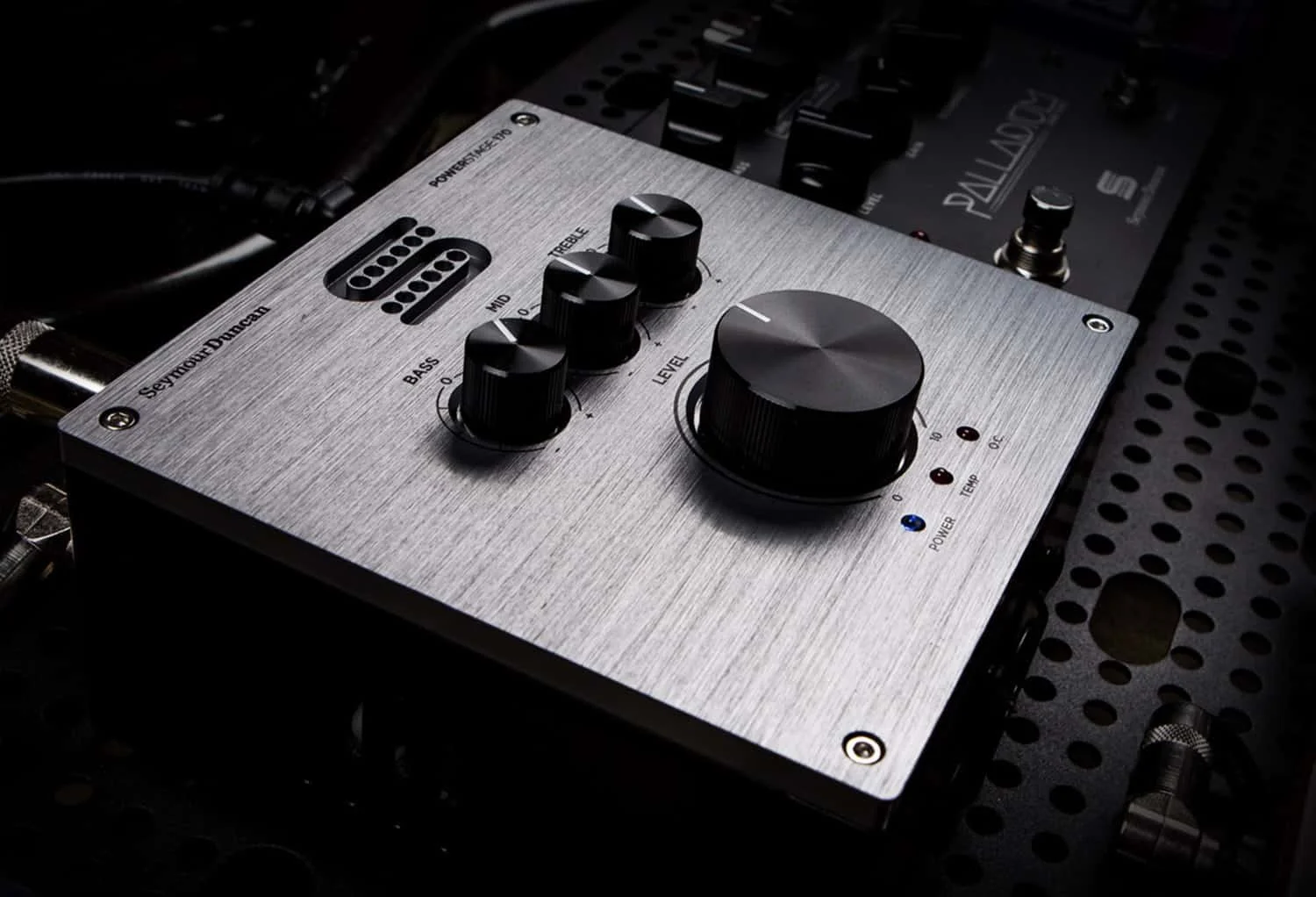Pedal Baby vs Powerstage vs Amped1
Not all power amps are made equal.
- Cheap
- Amp-like tone
- Biggest unit here
- Not transparent
- Ultra-portable
- Transparent
- Very expensive
- Transparent can be dull
- Portable
- Feature packed
- Complex
Recently portable power amps have been gaining popularity, due to advancements in modelling technology and the plethora of new preamp pedals. A power amp can take a line (guitar) level signal and amplify it in order to be able to drive a guitar speaker cabinet. This has several advantages over powered (FRFR) speakers and regular guitar amplifiers.
All three units are much smaller and lighter than a typical amp head. They will easily fit in a backpack or carry-on luggage on a plane. It also eliminates the need for carrying a speaker, since almost all venues and practice rooms will already have a viable cabinet available.
I tried the Orange Pedal Baby and the Seymour Duncan Powerstage 170 & 200 at a store with my own HX Stomp and a Celestion V30 cabinet. The Powerstage was much easier for me to dial in. I bought the Powerstage 170 and have been using it since then as my main amp. When the Blackstar Amped 1 came out, I spent about 30 minutes with it and was very impressed. It did not sound any better than my Powerstage, so I did not end up buying it.
Lately, I have been experimenting with just using the effects loop return of whatever amp is available at the practice space or gig venue, eliminating the need for a power amp altogether. I recommend trying that first before spending money on a dedicated power amplifier.
Orange Pedal Baby
“a power amp for pedalboard setups. (..) if your pedalboard or modeller has every tone you’ll ever need but you miss that “big, loud amp” feel…”
Ok, so what does that mean? Do I just plug in my Big Muff into the Pedal Baby and it will sound like an Orange Rockerverb amp? If I am using my Helix, should I model the Amp, or just the preamp?
As you can see in this Andertons video, the Pedal Baby is not easy to dial in without a preamp pedal or modelling gear. It would be the same as plugging your guitar directly into the return signal of your amp’s effects loop instead of using the guitar input. It is not to say that you cannot get a good sound this way. You would need to use different EQ strategies than you’re used to with a typical preamp+poweramp setup. If you want the Pedal Baby to behave more like a valve amp, you need a preamp. You can use the models found in the Helix or a dedicated preamp pedal, like the Friedman BE-OD or an Orange Guitar Butler. If you are using a Helix (or similar) make sure to only model the preamp, rather than the whole amplifier.
What are the drawbacks? None, really. Especially if you consider the modest £250 price tag and use it the way it was intended. It is worth noting that it is a class A/B power amplifier. It will have considerably lower power efficiency than a Class D power amp. The wasted power will be converted to heat, so the unit will need to be bulkier to facilitate airflow. The big benefit of a class A/B amplifier is that it can power high-resistance speakers with little loss in volume. It can output 70W into a 16Ohm speaker, which will still be plenty loud for almost any gig! It will also slightly change its tone as you turn up the volume - not dissimilar from a valve amplifier.
What if you want an even more portable solution for your rig?
Seymour Duncan Powerstage
“...voiced like a guitar power section, you may want to remove the digital power amp simulation from your modelled tones for optimum results.”
Seymour Duncan have a whole page dedicated to helping you get the most out of your Powerstage. They go over the recommended order of effects, how to use it with or without preamp pedals and how to best utilise modelling gear with the Powerstage. They really have everything covered there, including the fact that those are just suggestions and you can also get a great tone by completely disregarding their advice!
In my experience, the Powerstage does not alter its input very much at all, allowing me to use full amp modelling (preamp + power amp). This is extremely useful, as I can dial in the perfect tone on my HX stomp at home with headphones; then turn off the cab sims and head to practise and get an almost identical sound! I can even prepare for a gig in advance, by using the cab sims of whatever cabinet will be available at the venue!
The Powerstage 170 is the smallest and least feature-packed amp in the lineup. It costs £360. At 0.9kg (2lbs), it is barely larger than an effects pedal. Being Class D, it can only deliver its rated 170W of power to a 4Ohm speaker. If you are using a 16Ohm speaker, it will only be able to deliver a quarter of that. This should not be an issue. Even at maximum volume, the Powerstage does not distort or alter your tone! 42W should still be plenty for all, but the largest of arenas, in which case you can probably afford the 700W version. It is also worth noting that of all the units in this review, the Powerstage 170 is what I chose to purchase for myself after playing it side by side with the Orange Pedal Baby.
The Powerstage 200 is not going to be much louder, but it will offer some additional features. In addition to the 3-band EQ it has a presence control. You get an XLR output for recording or sending to the PA system. That comes with speaker simulation as well. You also get an auxiliary input for backing tracks. It has stereo outputs, although without stereo inputs it has limited functionality. Not earth-shattering, but a decent set of additional features for £140 more.
The Powerstage 700 is very expensive. At £650 it is more than double the price of the Orange Pedal Baby. It is louder than the 170W version, but not as much as you would expect. All 3 Seymour Duncan Powerstage amps retain perfect clarity at max volume, so you are unlikely to need the extra headroom of the 700. The 700 is also missing the aux input, but it does have stereo inputs and outputs, as opposed to just the stereo outs on the 200. It is also about the same size as the Orange Pedal Baby, so a bit less portable than the 170 and 200.
Blackstar Amped 1
“…unique, high-headroom design does not compromise on output even at 16 Ohms. Get maximum power and optimum tone with any cabinet set-up at 8 or 16 Ohms.”
Confusing naming aside, I was really impressed with the Amped 1! It sounds very similar to the Powerstage with the ‘flat’ voice and ‘linear’ response settings. Same as with the Seymour Duncan units, you can use full amp modelling (without speakers) and get a great sound this way. You get the same 3 band EQ, a master volume and a gain control. It has XLR and headphone outputs. The cabinet simulation can be configured further in Blackstar’s Cabrig software. The Amped 1 weighs about the same as the smaller Seymour Duncan units at 3lbs (1.3kg). Another cool feature of the Blackstar is that it will have the same maximum output, regardless of the speaker cabinet rating. You will get a more consistent sound this way, wherever you play. Only thing to note is that the Amped 1 will not work with a 4 Ohm speaker cabinet.
The additional features it has are very useful if you are using a pedalboard with a preamp pedal. You get a good enough sounding reverb with a cool ‘freeze’ feature (I would still prefer adding a dedicated reverb pedal). You can choose between a USA or a UK voicing (similar to Fender and Vox) for the gain tone! The response selector lets you pair your flavour of power amp with an appropriate tube sound (typically 6V6 for a Fender sound). I don’t think these features are particularly useful if you are using a modeller, but it is still a nice addition.
Using the Effects Loop
I have recently stopped taking my Seymour Duncan Powerstage 170 to band practice. I just plug in my HX Stomp into the effects return of the Marshall JCM 2000 that is available. You would be surprised how clean the power amps are in Marshalls. At home I use my Revv D20, also often plugging into the effects loop return, instead of the guitar input. Keep in mind that this approach will be most similar in sound to the Orange Pedal Baby – you cannot use full amp modelling and need to only use a preamp pedal/model. Still, for £0 and more simplicity, this is definitely the approach you should consider first, before spending any money.
Bottom Line
All three units we compared are incredibly versatile power amps. Either one of them will probably suit your needs with a bit of EQ tweaking. Because of this, the Orange Pedal Baby wins on price point alone! I would also recommend going for the Pedal Baby if you are looking for more amp-like responsiveness from the master volume control. It is, however, bigger and heavier (3kg) than the other power amps.
The Seymour Duncan Powerstage units will have the best build quality and even their smallest 170W amp will likely be more than loud enough!
If you need headphone and XLR outputs, then you have a choice between the Blackstar Amped 1 and the Powerstage 200. The Blackstar will be a little cheaper and have a few additional features, but I still preferred the overall design and sound of the Seymour Duncan.
Other options worth considering are the Behringer GPA-100 for just £69 (this one might not be loud enough) or the boutique Milkman The Amp for £700+. There is also a series of pedalboard power amps by Victory Amps.






